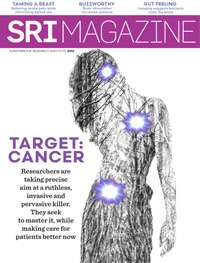Risk of deadly post-heart attack complication much higher if you have diabetes

MRI study finds previously unappreciated and potentially fatal link
June 13, 2016

Illustration by Gary Neill
According to projections by the World Health Organization, diabetes will be the seventh leading cause of death by 2030, affecting some 350 million people. In Canada, one in 10 deaths are diabetes related, and 10% of the population has a diagnosis of Type 2 diabetes, with many more in the prediabetic phase. People with diabetes are prone to blindness, kidney damage and, most dangerously, heart disease—called the frequently forgotten but often fatal complication. Researchers know little about why cardiac outcomes are so grave among these patients, but a study led by Dr. Idan Roifman, a cardiologist and scientist at Sunnybrook Research Institute in the Schulich Heart Research Program, is forging a new path in the diabetes-cardiac connection.
Roifman and his team looked specifically at right ventricular dysfunction (RVD), an often deadly complication following a major heart attack. A cardiac MRI was performed on 106 patients who’d suffered a heart attack a few days earlier. Of those who were found to have RVD, the presence of diabetes was shown to be a strong independent predictor, conferring an approximate threefold greater odds. “None of the other major risk factors, like smoking or hypertension, predicted the development of RVD,” says Roifman. “Only diabetes. So the question is, why?”
The answer, Roifman surmises, has to do with the microvasculature—the small blood vessel system—which is particularly vulnerable in diabetes. “Small vessel disease is a hallmark of diabetes,” he says. And because the right ventricle is fed more heavily by micro vessels than the left ventricle, diabetic patients may be more prone to develop RVD after a heart attack. He adds, “Perhaps diabetic microvascular disease is also weakening some of the natural protective mechanisms of the right ventricle.”
Though the underlying basis of the diabetes-RVD link will instigate future research, Roifman’s study is the gateway to solving a major clinical problem. His was the first study to look at predictors for RVD as measured by cardiac MRI, which he calls a game-changer in the field. “In the past 10 years, the MRI technology has matured and allowed us to look at the right ventricle in a much more accurate and detailed manner. We’ve discovered that there’s more RVD than we had initially thought.” Comparably little is known about the right ventricle; historically, cardiac research has focussed on the left side, because it was easier to image and its disorders were thought to be more prevalent. A better understanding of RVD and at-risk patients will be crucial in informing screening and treatment strategies.
“Finding out the predictors of RVD is an important first step,” Roifman says. “Because then we can predict which patients in the coronary care unit are at higher risk of developing this complication. In the long run, if microvascular disease is the culprit, we can try to develop novel therapeutics to target the problem.”
“We’ve got a huge clinical problem,” says Dr. Kim Connelly, a cardiologist and scientist at St. Michael’s Hospital, and a senior author of the study. “And right now, we have no specific treatments for the right ventricle. If you’re a diabetic and your right ventricle is falling apart, there are various blanket treatments we can give you, but nothing specific.”

"I limit myself to one glass of wine a day."
Connelly notes that there is a promising new Type 2 diabetes drug on the market (empagliflozin; trade name Jardiance), a SGLT2 inhibitor that in a large clinical trial was shown to reduce substantially heart failure hospitalizations and cardiac deaths. It’s huge news in the field. Most diabetes drugs work to lower blood glucose levels—important for reducing blindness and kidney damage—but in isolation have no effect on the risk for cardiovascular disease. Connelly is enthusiastic about the new drug, but cautions that the mechanisms remain a mystery. “We don’t know how this drug actually works,” he says. “We don’t know how it affects the microvasculature. And we need to know this so we can start to personalize treatments.”
More research to elucidate the connection between diabetic microvascular dysfunction and cardiac events is already underway. Roifman’s next study will look at how people with diabetes and microvascular disease fare after suffering a smaller, less severe heart attack. (These have been found to cause higher rates of death among diabetics compared with non-diabetics.) Roifman and his team will use cardiac MRI to study the microvasculature damage of participants and determine if it can be associated with heart attack death.
“A better understanding of the relationship between diabetes, microvascular disease and clinical outcomes will hopefully allow us to develop better treatment options,” says Roifman. “Our hope is to eventually be able to improve both the quality and length of life of those patients suffering from diabetes.”
Roifman is supported by an AstraZeneca Impact Challenge Grant in Cardiovascular Research, which is jointly provided by the Heart and Stroke/Richard Lewar Centre of Excellence in Cardiovascular Research, and the Banting and Best Diabetes Centre. Connelly is supported by a New Investigator Award from the Canadian Institutes of Health Research. Infrastructure support for Roifman was provided by the Canada Foundation for Innovation, and the Ontario Ministry of Research and Innovation.



